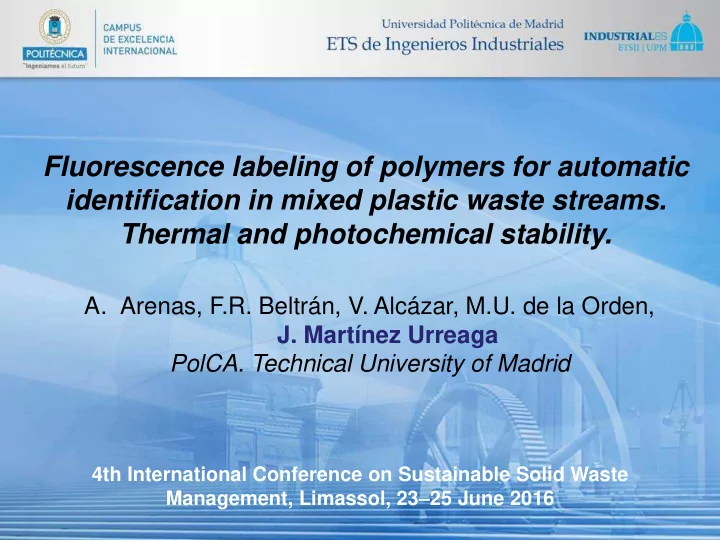

Fluorescence labeling of polymers for automatic identification in mixed plastic waste streams. Thermal and photochemical stability. A. Arenas, F.R. Beltrán, V. Alcázar, M.U. de la Orden, J. Martínez Urreaga PolCA. Technical University of Madrid 4th International Conference on Sustainable Solid Waste Management, Limassol, 23–25 June 2016
Introduction Source: Plastic Europe Mechanical (secondary) recycling is the best alternative for most plastics. The new EU targets are very ambitious and represent a big scientific and technological challenge. 1
Introduction Nowadays manual and automated separation processes are used for the sorting. Automated processes are cheap but their actual separation capacity is still far away from 100 %. In recent years, different methods based on the use of fluorescent markers have been proposed for the identification and automated sorting of different plastics waste. 2
Introduction HDPE is growing in the recycling market because it is easy to be recovered and reprocessed and there are applications for the recycled plastic, for instance in the packaging of cleaning products (not in food packaging). Recovered HDPE DIAPOSITIVA 3 3
The tracer We have studied the use of fluorescent tracers to aid in removing certain HDPE products. Among the required conditions for the tracer, the following can be highlighted: 1. The fluorescent emission must be clearly distinguishable. 2. The emission intensity should be high enough to keep the concentration of tracer to a ppm level. 3. The fluorescent tracer must be easily incorporated into the plastic. 4. The migration of the tracer to the environment must be minimal. 5. The fluorescent labeling must be resistant against thermal, photochemical and hydrothermal degradation. 4
Tracers Fluorescence of commercial products Acetone Irganox B900 HDPE-Irg Intensity (a. u.) 400 450 500 550 600 650 Wavelength (nm) 5
Tracers Two markers were evaluated. Rhodamine 6G is a commercial cationic fluorescent dye, which was introduced into HDPE in two ways, either directly or immobilized in a layered silicate Rhodamine-6G (R6G) Irganox B900 + CaCO 3 HDPE montmorillonite R6G-modified clay 6
Tracers The second marker (V-Quin) was a quinacridone synthesized in the laboratory with C14 substituents for improving the stability in HDPE. NH 2 (commercial) H C 14 H 29 H 3 COOC N H 3 COOC OH C 14 H 29 COOCH 3 H 3 COOC 60% 88% C 14 H 29 N COOCH 3 HO COOCH 3 1 H 3 2 (commercial) 76% H O H O C 14 H 29 N C 14 H 29 N C 14 H 29 N C 14 H 29 N 78% H O 5 H O 4 Synthesis of quinacridone with C14 substituents (V-Quin) 7
Results Fluorescence and stability of labeled plastics HDPE labeled with R6G-Clay. Photochemical degradation 0 h 100 h HDPE-Irg Intensity (a. u.) 550 600 650 700 750 800 Wavelength (nm) Fluorescence emission spectra ( λ ex = 510 nm) corresponding to HDPE labeled with R6G-modified clay, measured before (black) and after (red) 100 h of photochemical degradation. 8
Results Fluorescence and stability of labeled plastics HDPE labeled with R6G without clay. Hydrothermal degradation Time (h) 0 10 20 Intensity (a. u.) Intensity (a. u.) 236 Solution 308 Plastic HDPE-Irg 550 600 650 700 0 100 200 300 400 Wavelength (nm) Time (h) Time evolution of the emission intensity ( λ ex = 510 nm) of Evolution of the fluorescence emission of HDPE-R6G ( λ ex HDPE marked with R6G and its immersion medium during = 510 nm) during the hydrothermal degradation at 80 o C. the hydrothermal degradation. 9
Results Migration of R6G Not encapsulated Intensity (a.u.) Encapsulated R6G C-R6G 0 100 200 300 400 Time (h) Time evolution of the emission intensity of the immersion media ( λ ex = 510 nm) during the hydrothermal degradation of HDPE marked with R6G and R6G-modified clay. 10
Results Fluorescence and stability of labeled plastics HDPE labeled with V-Quin. Hydrothermal degradation Time (h) 0 10 20 188 Intensity (a. u.) 308 HDPE-Irg 400 450 500 550 600 650 Wavelength (nm) Evolution of the fluorescence emission of HDPE marked with V- Quin ( λ ex = 350 nm) during the hydrothermal degradation at 80 o C. 11
Results Stability with R6G and V-Quin 1.0 Relative intensity (I/I 0 ) V-Quin R6G 0.8 0.6 0.4 0.2 0 100 200 300 400 Time (h) Retention of the fluorescence emission of HDPE marked with R6G and V-Quin during the hydrothermal degradation. 12
Conclusions 1. The fluorescent tracers rhodamine-6G and V-Quin allow the correct identification of the marked HDPE in mixed plastics streams. 2. The good stability of the fluorescent emission indicates that the marked plastics will be properly detected even after a long lifetime. 3. The intercalation of rhodamine-6G between clay nanosheets reduces the leaching of the tracer during the hydrothermal degradation. 4. V-Quin shows better stability and better anchoring to polyethylene than rhodamine-6G. 5. The fluorescent labeling of some products can be very useful for improving the recycling of HDPE. 13
Thanks for your attention Contact information: e-mail: joaquin.martinez@upm.es 14
Tracers 1600 CNa Characterization of the modified C-R6G montmorillonite. 1200 Intensity(a. u.) 800 400 100 0 80 2 4 6 8 10 Weight (%) 2 θ 60 XRD traces corresponding to unmodified clay (CNa) and CNa modified with R6G 40 CNa C-R6G 20 R6G 0 0 200 400 600 800 Temperature ( ° C) Thermogravimetric traces corresponding to unmodified clay (CNa), R6G and CNa modified with R6G 15
AlP + 3 H 2 O → Al (OH) 3 + PH 3 DIAPOSITIVA 16
Recommend
More recommend